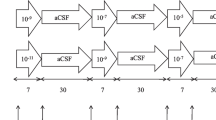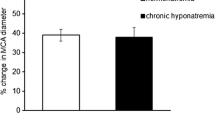Summary
The present studies were performed in order to determine whether “filtration edema” will develop as a consequence of cerebral vasoparalysis, vasoparalysis in combination with arterial hypertension or arterial hypertension alone. A series of dogs, anaesthetised with i.v. Chloralose-Urethane were exposed 1) to cerebral vasoparalysis, produced by hypercapnia (PaCO2 about 150 mm Hg) and hypoxaemia (PaO2 40–60 mm Hg); 2) to arterial hypertension and 3) to a combination of cerebral vasoparalysis and arterial hypertension. Following cerebral vasoparalysis and arterial hypertension, a significant decrease of total cerebrovascular resistance and moderate increase of venous resistance was observed. Regional cerebral blood flow (133Xe), intracranial pressure, as well as the pressure in postcapillary venous outflow (sinus sagittalis wedge pressure and confluence sinuum pressure) were increased. Neither normotonic vasoparalysis nor vasoparalysis in combination with slight arterial hypertension (MABP more than 90 min above 180 mm Hg) resulted in cerebral edema. In contrast, cerebral vasoparalysis in combination with severe arterial hypertension (MABP more than 90 min above 220 mm Hg) resulted in a statistically significant increase in the water content in the white matter without evidence of protein extravasation. Multiple small foci of Evans blue extravasates, however, were found in the cortex following arterial hypertension in combination with vasodilation, indicating a damage of the blood brain barrier. In these blue stained cortical areas the water content was significantly increased. The following conclusions were drawn from the results. Vasoparalysis during normotension does not produce brain edema despite the slightly elevated hydrostatic pressure gradient between intravasal and extracellular space. Only considerable increase of this hydrostatic pressure gradient caused by a combination of vasoparalysis with severe arterial hypertension is able to produce brain edema in the white matter. In addition, acute hypertension may cause minor multifocal damage of the blood brain barrier in the cerebral cortex. It is concluded that so-called brain swelling, which has been described by several authors in states of cerebral vasoparalysis, is not predominantly caused by brain edema but by vascular congestion. The clinical aspects of the result are discussed.
Zusammenfassung
In den vorliegenden Untersuchungen sollte die Frage eines sogenannten Filtrationsödems im Rahmen einer cerebralen Vasoparalyse und/oder einer arteriellen Hypertension geklärt werden. Bei Gruppen von Hunden wurde in Chloralose-Urethan-Narkose eine cerebrale Vasoparalyse durch Hyperkapnie (PaCO2 um 150 mm Hg) und Hypoxämie (PaO2 40–60 mm Hg), eine arterielle Hypertension sowie eine Kombination von Vasoparalyse und arterieller Hypertension erzeugt. Unter den Bedingungen einer Vasoparalyse und Hypertension kommt es zu einem erheblichen Abfall des cerebrovasculären Widerstandes, während der venöse Widerstand geringgradig ansteigt. Die Folge ist eine Zunahme der Hirndurchblutung, eine Zunahme des intrakraniellen Druckes sowie eine Druckzunahme im postcapillären Bereich (SSWP und CSP). Ein Hirnödem in verschiedenen Hirnarealen konnte bei alleiniger Vasoparalyse bei intakter Blut-Hirn-Schranke nicht nachgewiesen werden, selbst wenn der arterielle Blutdruck mehr als 90 min über 180 mm Hg lag. Erst wenn neben der Vasoparalyse die arterielle Hypertension länger als 90 min über 220 mm Hg bestand, konnte eine statistisch signifikante Zunahme des Wassergehaltes in der weißen Substanz gefunden werden. Unabhängig davon fanden sich in der Hirnrinde nach arterieller Hypertension wie auch nach Hypertension und Vasoparalyse punktförmige Evans-Blau-Extravasate, welche eine Schädigung der Blut-Hirn-Schranke anzeigen. In diesen blaugefärbten, punktförmigen Arealen lag der Wassergehalt deutlich über der Norm. Aus den Ergebnissen wird geschlossen, daß die Vasoparalyse allein nicht in der Lage ist, ein Hirnödem über den erhöhten hydrostatischen Druckgradienten zwischen Intravasalraum und Extracellulärraum zu erzeugen. Erst wenn sich zu der Vasoparalyse eine stärkere arterielle Hypertension addiert, findet sich in den Arealen der weißen Substanz ein solches Ödem. Die akute Hypertension selbst ist aber in der Lage, in der Hirnrinde fokale Störungen der Blut-Hirn-Schranke auszulösen. Das von mehreren Autoren bei den klinischen Zuständen von Vasoparalyse beschriebene „brain swelling“ kann demnach nicht bzw. nicht allein auf Hirnödem zurückgeführt werden, sondern ist meist durch das erhöhte Blutvolumen zu erklären. Die klinischen Konsequenzen dieser Befunde werden diskutiert.
Similar content being viewed by others
Literatur
Bakay, L., Lee, I. C.: The effect of acute hypoxia and hypercapnia on the ultrastructure of central nervous system. Brain 91, 697–700 (1968)
Brock, M.: Regional cerebral blood flow (rCBF) changes following local brain compression. Scand. J. clin. Lab. Invest. 22, Suppl. 102, XIV, A (1968)
Byrom, F. B.: The pathogenesis of hypertensive encephalopathy and its relation to the malignant phase of hypertension. Lancet 1954 II, 201–211
Frei, H. J., Wallenfang, Th., Pöll, W., Reulen, H. J., Schubert, R., Brock, M.: Regional cerebral blood flow and regional metabolism in cold induced oedema. Acta Neurochir. 29, 15–28 (1973)
Hadjidimos, A., Fischer, F., Reulen, H.-J.: Restitution of vasomotor autoregulation by hypocapnia in brain tumors. In: Advances in neurosurgery, Bd. 3. Berlin-Heidelberg-New York: Springer (im Druck)
Häggendal, E., Johansson, B.: Effects of arterial carbon dioxide tension and oxygen saturation on cerebral blood flow autoregulation in dogs. Acta physiol. scand. 66, Suppl. 258, 27–53 (1965)
Häggendal, E., Johansson, B.: Pathophysiological aspects of the blood brain barrier change in acute hypertension. Europ. Neurol. 6, 24–28 (1971/1972)
Heipertz, R.: The effects of local cortical freezing of rCBF in the cat. Scand. J. clin. Lab. Invest. 22, Suppl. 102, XIV, D (1968)
Heuser, D. E.: Die zeitlichen Änderungen der Gehirndurchblutung bei Alkalose und Acidose des Blutes im akuten Experiment. In: Pharmakologie der lokalen Gehirndurchblutung (Hrsg. E. Betz, R. Wüllenweber), S. 82–87. München-Gräfelfing: Werk-Verlag Dr. E. Banaschewski 1969
Ingvar, D. H., Lassen, N. A.: Regional blood flow of the cerebral cortex determined by Krypton-85. Acta physiol. scand. 54, 325–338 (1962)
Ingvar, D. H.: The pathophysiology of cerebral anoxia. Acta anaesth. scand., Suppl. XXIX, Aspects of resuscitation, S. 47–54 (1968)
Johansson, B., Olsson, Y., Klatzo, I.: The effect of acute arterial hypertension on the BBB to protein tracers. Acta neuropath. (Berl.) 16, 117–124 (1970)
Kety, S. S., Polis, D., Nadler, C. S., Schmidt, C. F.: The blood flow and oxygen consumption of the human brain in diabetic acidosis and coma. J. clin. Invest. 27, 500–510 (1948)
Kung, P. C., Lee, J. K., BaKay, L.: Electron microscopie study of experimental acute hypertensive encephalopathy. Acta neuropath. (Berl.) 10, 263–272 (1968)
Langfitt, T. W., Mashall, W. J. S., Kassel, N. F., Schutta, H. S.: The pathophysiology of brain swelling by mechanical trauma and hypertension. Scand. J. clin. Lab. Invest. 22, Suppl. 102, XIV, B (1968)
Langfitt, T. W., Weinstein, I. D., Sklar, F. H., Zaren, H. A., Kassel, N. F.: Contribution of intracranial blood volume to three forms of experimental brain swelling. Johns Hopk. med. J. 122, 261–270 (1968)
Lassen, N. A., Ingvar, D. H.: The blood flow of the cerebral cortex determined by radioactive Krypton-85. Experientia (Basel) 17, 42–43 (1961)
Lassen, N. A., Paulson, O. B.: Partial cerebral vasoparalysis in patients with apoplexy: Dissociation between dioxide responsiveness and autoregulation. In: Cerebral blood flow (Hrsg. M. Brock, C. Fieschi, D. H. Ingvar, N. A. Lassen, K. Schürmann), S. 117–119. Berlin-Heidelberg-New York: Springer 1969
Leusen, D. W., Granholm, L.: Discussion and comments to section III on hypoxia and acid/base parameters in brain and CSF. Scand. J. clin. Lab. Invest. 22, Suppl. 102, III, F (1968)
Marshall, J., Fieschi, C.: Discussions and comments to section XVI on regional cerebral blood flow in apoplexy. Scand. J. clin. Lab. Invest. 22, Suppl. 102, XVI, I (1968)
Marshall, J., Jackson, J. L. F., Langfitt, T. W.: Brain swelling caused by trauma and arterial hypertension. Arch. Neurol. 21, 545–553 (1969)
McDowall, D. G., Harper, A. M.: Cerebral oxygen uptake and cerebral blood flow during the action of certain anaesthetic agents. In: Pharmakologie der lokalen Gehirndurchblutung (Hrsg. E. Betz, R. Wüllenweber), S. 108–110. München-Gräfelfing: Werk-Verlag Dr. E. Banaschewski 1969
Meinig, G., Reulen, H. J., Hadjidimos, A., Simon, Ch., Bartko, D., Schürmann, K.: Induction of filtration edema by extreme reduction of cerebrovascular resistance associated with hypertension. Europ. Neurol. 8, 97–103 (1971/1972)
Norris, J. W., Pappius, H. M.: Cerebral water and electrolytes. Arch. Neurol. 23, 248–258 (1970)
Palvölgyi, R.: Regional cerebral blood flow in tumor patients. Scand. J. clin. Lab. Invest. 22, Suppl. XV, B (1968)
Paulson, O. B.: Regional cerebral blood flow in apoplexy due to occlusion of the middle cerebral artery. Neurology (Minneap.) 20, 63–77 (1970)
Reulen, H. J., Hadjidimos, A., Schürmann, K.: The effect of dexamethasone on water and electrolyte content and on rCBF in perifocal brain edema in man. In: Steroids and brain edema (Hrsg. H. J. Reulen, K. Schürmann), S. 239–252. Berlin-Heidelberg-New York: Springer 1972
Schutta, H. S., Kassel, N. F., Langfitt, T. W.: Brain swelling produced by injury and aggravated by arterial hypertension. Brain 91, 281–294 (1968)
Schutta, H. S., Langfitt, T. W., Kassel, N. F.: Fine structure study of brain swelling induced by mechanical injury. Scand. J. clin. Lab. Invest. 22, Suppl. 102, XIV, C (1968)
Shulman, K., Verdier, G.: Cerebral vascular resistance changes in response to cerebrospinal fluid pressure. Amer. J. Physiol. 213, 1084–1088 (1967)
Sokoloff, L.: The effects of carbon dioxide on the cerebral circulation. Anesthesiology 21, 669–673 (1960)
Symon, L.: Hyperaemia in the cerebral circulation. In: Brain and blood flow (Hrsg. R. W. R. Russell), S. 195–199. London: Pitman Medical and Scientific 1970
Author information
Authors and Affiliations
Additional information
Mit Unterstützung durch die Deutsche Forschungsgemeinschaft.
Rights and permissions
About this article
Cite this article
Meinig, G., Reulen, H.J., Simon, C. et al. Cerebrale Vasoparalyse, arterielle Hypertension und Hirnödem. J. Neurol 211, 25–38 (1975). https://doi.org/10.1007/BF00312461
Received:
Issue Date:
DOI: https://doi.org/10.1007/BF00312461




